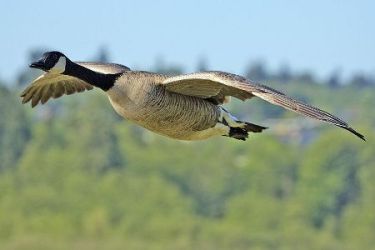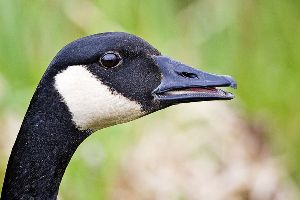Navigation
Adaptation
How has the Canadian goose adapted to its environment and habitat?
Unfortunately, the Canadian goose is known by most as the
easiest bird to call and decoy. This makes it very easy to hunt
and catch these birds. However; the geese are found in flocks at all
times of the year except when nesting. This can make it
difficult for predators other than humans to capture their prey.
Canadian geese also have very good eyesight and hearing. Sight
is the bird's dominant sense. Compared to a mammal's eyes, they
are comparatively immobile; however, birds are able to rotate
their heads greater distances. Birds are also able to focus
their eyes very quickly which is essential during flying. They
have a large field of sharp vision.
During
breeding, the geese separate and guard their nests. If they feel
threatened, they will chase the predator and flap its wings as a
weapon. As a scare tactic, they will open their wings as wide as
possible to appear bigger and more daunting.
How do they move?
 The Canadian geese can be found either on land, in the water,
or in the air. On land, the geese move via waddling, a very
silly type of walk with their webbed feet. In water, these
webbed feet come in handy. The duck uses its feet to paddle
through water by providing more area to thrust. In the air, the
geese use the recognizable V formation or diagonally straight
lines. These formations minimize drag on the individuals and
gives the flock a streamlined shape. The feathers of geese have
many advantages. They allow flight and are much better
insulators than mammalian hair. Feathers are made of keratin.
Once they are fully grown, they are completely dead tissue;
however, feathers are replaced annually.
The Canadian geese can be found either on land, in the water,
or in the air. On land, the geese move via waddling, a very
silly type of walk with their webbed feet. In water, these
webbed feet come in handy. The duck uses its feet to paddle
through water by providing more area to thrust. In the air, the
geese use the recognizable V formation or diagonally straight
lines. These formations minimize drag on the individuals and
gives the flock a streamlined shape. The feathers of geese have
many advantages. They allow flight and are much better
insulators than mammalian hair. Feathers are made of keratin.
Once they are fully grown, they are completely dead tissue;
however, feathers are replaced annually.
How do their structures relate to their function?
 Along with the webbed feet and wings, Branta canadensis also have a bill that is very useful.
The bill has serrated edges that are used to strain water. The
front of the beak is used to cut strips of kernels and clip
grasses with the use of lamellae- ridges that are used as a cutting tool.
The tongue of Canadian geese are also useful. They are sensitive
with small spiny projections on them which are used for sifting
through food. Canadian geese also have long necks that allow the bird
to tip over in water and search for food.
Along with the webbed feet and wings, Branta canadensis also have a bill that is very useful.
The bill has serrated edges that are used to strain water. The
front of the beak is used to cut strips of kernels and clip
grasses with the use of lamellae- ridges that are used as a cutting tool.
The tongue of Canadian geese are also useful. They are sensitive
with small spiny projections on them which are used for sifting
through food. Canadian geese also have long necks that allow the bird
to tip over in water and search for food.
The skeleton of birds is modified for flight. It is light and
is very powerful which is necessary for flight. Muscles are in the center
of the body in places such as the breast, and bases of the wings
and legs. The bones of the bird's skeleton are hollow and
several are fused together in order to have a strong, light
frame. The skeleton makes up only five percent of the bird's
mass!
Because birds lack a diaphragm, they have evolved air sacs
surrounding their lungs. Respiration is much more efficient in
birds than in mammals. They can use approximately twenty fiver
percent more oxygen from each breath versus a mammal. Birds,
like mammals, generate their own heat.
Learn more about the nutrition of Branta canadensis. Return home.